Physics

"We haven't the foggiest idea what drives the new high-temperature
superconductors, or what makes a snowflake, or how the mind or the
economy works. What is more, nothing high energy physics can do will ever be of the slightest direct help in solving these overwhelmingly hard problems"
Philip Anderson, The Case Against the SSC, 1987(Anderson was one of the theorists who are credited for discovering the "Higgs mechanism" in the early 1960s. He is a 1977 Nobel laureate in Physics for his studies of the electron structure of magnetic systems)
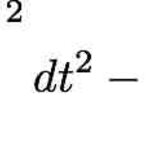
Classical gravity is not good enough. As a first step, one must think about groups since that is the foundation of the Standard Model of physics.
All my failed efforts to think about gravity in new ways were variations on the Maxwell equations. Groups struck me as too hard. I might never be able to comprehend SU(5), SU(10), or E8, where studies on unified fields take place.
There are a few things I know about the standard model. The strong force is based on the gauge symmetry of the continuous Lie group SU(3). There are eight generators in its Lie algebra, su(…
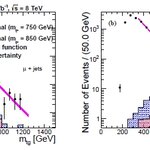
The top quark is the most massive elementary particle that we have so far discovered at particle accelerators. One usually describes this by saying that the top mass is about 185 times larger than the mass of a whole proton; but since the proton is a composite object, it is not the best comparison stone; I would prefer to compare the top mass to the mass of the lightest quark, which we only roughly know to be in the range of a 2 to 5 MeV. Then one gets a more dramatic picture: the up quark and the top quark are both elementary particles, but the latter is 50,000 times larger than the former.…
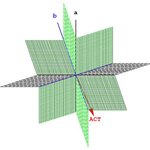
I may today perhaps make the boldest claim I ever made, at least many will think so, and I am not known for my humbleness (though I should be – how many established scientists do see themselves as merely a perverted, psychopathic robot?): The world’s first ever touchable, functioning quantum many-worlds model that can violate John Bell’s inequality even stronger than standard quantum mechanics!
A model with standard quantum probabilities – every little area is a parallel world. The red arrow ACT represents the ‘actualization’ of a single future which realists insist on. ACT tried to…
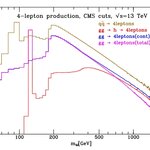
In a paper appeared a few days ago on the Cornell Arxiv Campbell, Ellis and Williams discuss how the LHC experiments have a chance to obtain information on the Higgs boson width by studying four-lepton events at masses much above the 126 GeV region where they cluster when produced by Higgs boson decays. Here I am going to show the graph that is at the source of this idea, and the general conclusions that the theorists reach on the precision that ATLAS and CMS can obtain on that parameter.
First of all let me explain to outsiders what is the Higgs boson width. In order to do so I need to make…

It happens in 1995, toward the end of Run 1B of the Fermilab Tevatron, in the middle of a otherwise anonymous store. The CDF detector is taking good data, and the shift crew in the control room take care of the usual business - a look at the colourful monitors that plaster the walls, a check at trigger rates, the logging of a few standard warnings issued by the data acquisition system, and the occasional browsing of e-mails.
But somewhere above the control room, some 100 kilometers over Lake Michigan, a particle reaction is taking place. A very energetic proton coming from another…

"This time we're shooting through a brick!"
Larry Nodulman (during a discussion on the reconstruction of electrons in the CDF II detector, just refurbished with a new set of silicon microstrip layers (SVX'), more powerful and capable of identifying the impact parameter of charged tracks with a dozen micron accuracy, but also heavier and bulkier than its predecessor, and thus providing more material for multiple scattering of particles.)
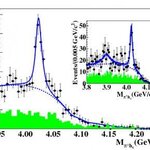
An international team of high-energy physicists says the discovery of an electrically charged subatomic particle called Zc(4020) is a sign that they have begun to unveil a whole new family of four-quark objects.
The Beijing Spectrometer (BESIII) collaboration previously announced the discovery of a four-quark particle called Zc(3900) in April of this year. The results have come about through a dedicated study of the byproducts of the anomalous Y(4260) particle.
Using the Beijing Electron Positron Collider (BEPCII) in China, scientists tuned the energy at which…

These days I am trying to reconstruct some stories from my old experiment, CDF. The CDF experiment was conceived in 1979 and constructed in the early eighties at the Fermi laboratories in Batavia, near Chicago. CDF took the first proton-antiproton collisions in 1985, and it collected data in1987-88, 1992-96, and 2001-2011, thus becoming the longest-lasting particle physics experiment in the history of science.
In 1994 CDF announced the first evidence of the top quark, measuring its mass at 174 GeV, a value which still holds its ground the increase by one order of magnitude of the precision…

Top scientists met at Fermi National Accelerator Laboratory, this past weekend, in the first of a series of face to face meetings which will help determine the course of particle physics in the United States of America for the next decade. This was the first face to face meeting of the Particle Physics Project Prioritization Panel. The community of physicists at and around Fermi National Accelerator Laboratory is only the first which will get to have its say. P5’s difficult task will be to strongly recommend which projects will get priority and which will wither. …